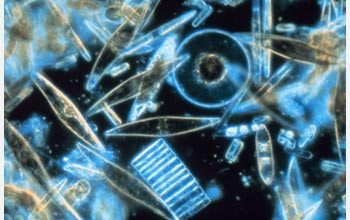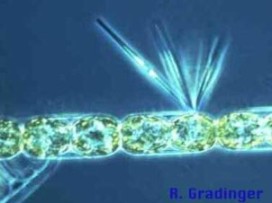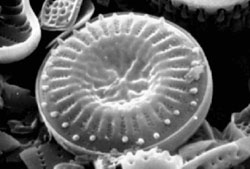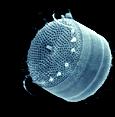
Adapations
Diatoms are extremely unique organisms. They are extremely
abundant photosynthetic algae, with a few exceptions which are
heterotrophic or mixatrophic. They store energy in the form of
oils and they usually produce extra cellular polysaccharides.
But on top of it all they have cell walls. Their cell walls
aren’t made of cellulose or peptidoglycan or any other complex
organic molecule. Instead they are surrounded in a silica
(glass) cell wall which is often call frustules.
polysaccharides.
But on top of it all they have cell walls. Their cell walls
aren’t made of cellulose or peptidoglycan or any other complex
organic molecule. Instead they are surrounded in a silica
(glass) cell wall which is often call frustules.
Now they
are also highly evolved to photosynthesis and they are one of the
most productive photosynthetic groups of organisms on earth. 20 to
25 percent of the total global net primary production is done by
these organisms. Several of their adaptations allow them to do this.
Three of the big ones are that they are able to store energy as oils
which also helps them with staying higher in the water column, they
have the strong silica frustules that p protects them from a large
amount of predation (more on the frustules in
reproduction and
facts), and they are able to grow virtually everywhere on the
plant. There are species of diatoms that live in the soil, the snow,
ice, arctic waters, Antarctic waters, tropical waters, rivers, and
possible even more places (more at habitat). This allows them to be extremely prolific
primary produces and a large portion of the base in many ecosystems.
protects them from a large
amount of predation (more on the frustules in
reproduction and
facts), and they are able to grow virtually everywhere on the
plant. There are species of diatoms that live in the soil, the snow,
ice, arctic waters, Antarctic waters, tropical waters, rivers, and
possible even more places (more at habitat). This allows them to be extremely prolific
primary produces and a large portion of the base in many ecosystems.
Other
specific adaptations will vary greatly between the 200,000 estimated
species. Although, very few species have developed any adaptations
that cause them to consisten tly form or need to participate in a
symbiotic relationships.
tly form or need to participate in a
symbiotic relationships.
Different diatom species have specific adaptations to their specific habitats that will be covered in habitats rather then here.
To Nutrition